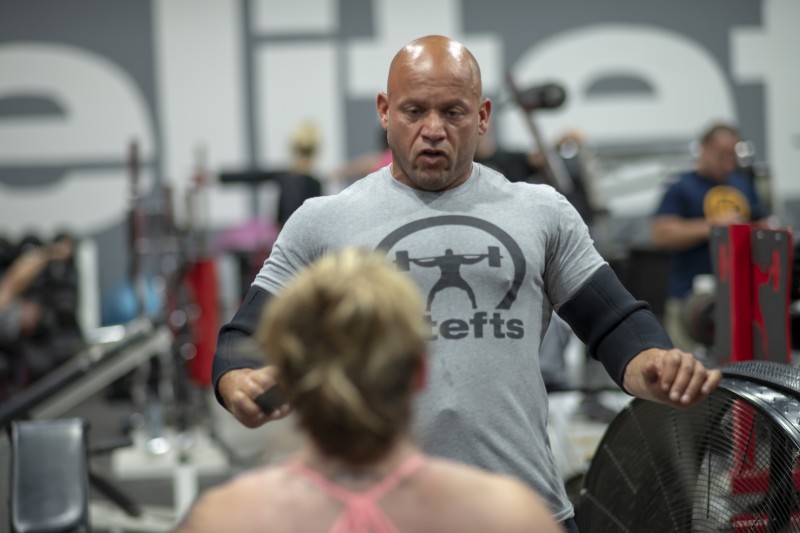
In every staff meeting, I’ve ever held where gym cleanliness has been a topic of conversation, it has been inevitable that one of the first ideas to be thrown out was addressing issues with signage. “We need to put up some signs!” Rack-your-weight signs, don’t-mix-bumpers-and-steel-plates signs, no-curling-in-the-squat-rack signs, don’t-be-an-asshole signs, and the list goes on. I am not against signage — sometimes it’s necessary to convey a message.
WATCH: Custom Equipment for Destination Dallas
It was always my belief that a gym’s culture was the way to steer member behavior, not management. The word “culture” is a complex word. It carries many meanings depending on the context of how it’s used. The following definitions are the context of culture that I’m talking about:
- The set of shared attitudes, values, goals, and practices that characterize an institution or organization
- The set of values, conventions, or social practices associated with a particular field, activity, or societal characteristic
It was and still is my belief that if you can steer those attitudes and practices, it’s 10x or even 100x more powerful than a sign is. I know this may sound vague and is not conducive to what people want out of a staff meeting. Leaving a staff meeting, people generally want to leave with a concrete set of actionable tasks. Preaching about culture solving cleanliness issues can very easily leave everyone’s list blank, which will eventually lead to frustration because their jobs start to feel ambiguous. This article addresses the philosophy of leading your gym through culture and steps you can take to steer that culture, as well as actionable steps the staff can take to address behavior and to keep a facility in tight order.
The Broken Window Theory
I’m an avid reader. I’m almost done with a goal I’ve had since college, which is to read 100 books. One author from whom I always have powerful takeaways is Malcolm Gladwell. In his book The Tipping Point, Malcolm tells a story about how New York City successfully cut crime rates in half in only a couple of years. His theory on how, along with the theme of the entire book, is that big change is achieved by a series of small events that cause a trend to “tip” in a certain direction. In the case of crime, he borrows from a theory created by criminologist James Wilson and George Kelling in 1982, the broken window theory.
The Broken Window Theory expresses crime is a result of disorder. If a window is broken and unrepaired, people will conclude that no one cares and no one is in charge. Soon, more windows will be broken, and a sense of anarchy will spread from building to street, sending a signal that anything goes.
Image credit: piccaya © 123RF.com
The New York Police Department and the City of New York cracked down hard on graffiti and public misdemeanors that in the past officers may have considered letting slide, to clean up all of the indicators that no one was in charge. Over time, this effort created a sense of order that made criminals far more intimidated or tempted to break the law, and crime dropped drastically.
This is so applicable to a gym. If you walk into a perfectly organized gym and start to train, wouldn’t you put your weights back on the rack after each exercise? Now if you walked into a gym where plates and dumbbells were scattered everywhere, you likely wouldn’t think twice about leaving your weights on the bar, right? Scattered weights are broken windows. A messy weight room begets messy behavior. Throwing “rack-your-weights” signs into a messy gym is a useless act, in my opinion, and sometimes can even have the opposite effect, causing members to say to themselves, “Don’t tell me what to do.” Other “broken windows” in facilities include messy bathrooms, gym bags scattered across counter spaces, chalk all over the floor, cable attachments all over the floor, smudges on the mirrors, sweat pools on the machines, and even behavioral broken windows, like the belittlement of other members (even in a joking manner), disrespect of staff, intimidation, gossip, and an attitude of exclusion. You can start to connect the dots on how keeping all of these little indicators tidy over time will create an atmosphere of a clean gym, both physically and amongst the air of the members.
Your Team’s To-Do Lists
How do you get from preaching about culture and criminology to a team member’s to-do list? The team’s role in this is to lead by example. The gym must start clean and organized every morning. The closing staff needs to get it 100% clean and prepared for the next day. The morning staff needs to double-check their work before the doors open. This is the base, but managing this throughout the day is where they really steer the behavior. The staff and trainers need to keep an eye out for little broken windows all day. Someone left those five-pound dumbbells by the treadmill, take them back. The leg press has eight plates on each side, un-rack them. It can feel demoralizing to be a house cleaner for a bunch of adults, but if you hit this hard, the problems will become less and less. As the member base gets used to an organized gym, they will begin to clean up after themselves, recognizing that they are in a clean facility and aiming to keep it that way. The staff also need to lead by example during their own workouts.
This is actually more important, in my opinion, than when they are on the clock. If they clean only when they are working, it sends the message that the staff are there to pick up after the members. If the staff clean up after themselves as staff and also during their personal workout times, then it keeps the message that we all clean up after ourselves. Staff may not understand if you or the management need to remind them to rack their weights during their personal workouts. They might get defensive. But usually, if you explain this so that they understand that it is only helping to build an atmosphere in which the gym cleans itself and that it will make their jobs easier for them when they are on shift — they’re usually happy to comply.
Steer the Culture
Let’s continue with the organized-weight-room discussion, which can be applied to any of the “broken windows” your facility may encounter. A to-do list for a respected manager or the owner is to make sure that the most influential members are onboard with the culture you’re trying to create. If the most accomplished athlete in the gym, someone everyone looks up to and emulates, is leaving his dumbbells everywhere or acting disrespectfully, it will be very difficult to create change. Culture is guided by influential people. The owners and staff need to act in a way that is in line with the culture you’re trying to create, but equally important are the influential members and personalities inside the facility.
I personally had this situation occur but did not know how important it was at the time to address it or how to go about it. In hindsight, I was saved by circumstance, but it enforced the lesson big time. My most influential member and his training partners were a big part of our gym’s community. Not only were they the ones whom people bragged about being in the gym with, but also they brought a ton of attention to our facility in the rise of the social media era, which was great. When they began to poke fun at other members or purposefully move equipment across the gym to irritate people with whom they didn’t get along, we experienced a big culture slide. The member base began to “click up,” and the atmosphere started to feel tense. A new gym opened in town, and we “lost” our most influential member. But a funny thing happened. New leadership emerged from within the member base. They didn’t carry the same notoriety, but they were good athletes, and people looked up to them in the gym all the same. The culture began to regain the family feeling we had worked so many years to build. In hindsight, I should have been very direct in solving this issue when I saw it begin to happen. To be honest with myself, I was afraid of losing the influential members and it caused inaction on my part. In reality, I should have either put a stop to the behavior or removed the influential member altogether to keep the gym’s culture intact. It would have been an extreme move, like a professional sport team removing its star player, but now it makes sense as to my why head coaches need to make hard personnel decisions like this to save their locker rooms.
Using culture and lessons from criminology may seem like an abstract way to keep a nice facility, but it’s an effective way to create an environment that is managed by values and attitudes as opposed to rules and rule enforcers.
References
- Definition of Culture from Merriam Webster: https://www.merriam-webster.com/dictionary/culture
Greg McCoy is a fitness entrepreneur located in Dallas, Texas. Greg has owned and operated two gyms in his nine-year career: Metroflex Gym of Plano and Destination Dallas. He frequently speaks and consults on a number of fitness business topics and serves in several charitable organizations. He received his bachelor’s degree from Oklahoma State University in 2008. Greg is a National Level Bodybuilder.













While I agree the staff at any gym is an important part of a "gym culture" that maintains an orderly, clean training environment, the members are ultimately the most important. Unfortunately, there will always be (and always have been) people young and old of all genders, and ethnicities who leave bars and equipment loaded, benches sweaty, plates and dumbbells where they don't belong. The problem is staff cannot instill common courtesy and common sense which is the underlying cause of the problem. I've trained for over 45 years, mostly in gyms, and I have yet to find a gym where every member unloads and cleans equipment after using it, although many do, thankfully. How many gyms exist where at any given time of the day you will not find plates left on equipment or plates improperly stored (45's stacked over lighter plats), few if any. In the past I would put away plates and dumbbells whether I used them or not, now (after wasting lots of time) I will only put away what I use. Sorry for my rant, and thank you for this article.